A Forest Garden is a planting which mimics an immature woodland, in which everything is edible or useful. Plants are grown using every available space - under the ground, on the ground, as bushes, trees and climbers. It requires minimal maintenance once established as all the plants are perennials or self seed easily and the ground is permenantly covered.
We hope these pages give a good idea of how our Forest Garden has evolved and if you'd like to know more, we run a one day Introduction to Edible Forest Gardening course at various times of the year. We also welcome group visitors for prearranged visits, and individuals are welcome to come on our workdays or spend more time with us on our WWOOF weeks .
Background
We decided to plant a Forest Garden because the idea of lots of food with minimal work appealed! We knew that setting up the Forest Garden would take quite a lot of time, effort and money, but once it was established we were hopeful that it would be a highly productive space requiring little intervention from us. We had a five year plan, to plant the area we had allocated (about 2 acres) in 5 phases, with the main planting of trees and bushes over the winter. Ground cover and other plants would be put in as and when we had them, with the aim of filling each phase as soon as possible. And in general, that is what has happened. We have had a tremendous amount of volunteer help, without which the Forest Garden wouldn't be what it is today - a big thank you to everyone who has helped in any way.
Here, we share the timeline, photos and experiences (good and bad) of the Forest Garden, from the first planting up to date. There are links to lots more photos at the bottom of the page.
Brief Timeline from November 2004 to April 2012
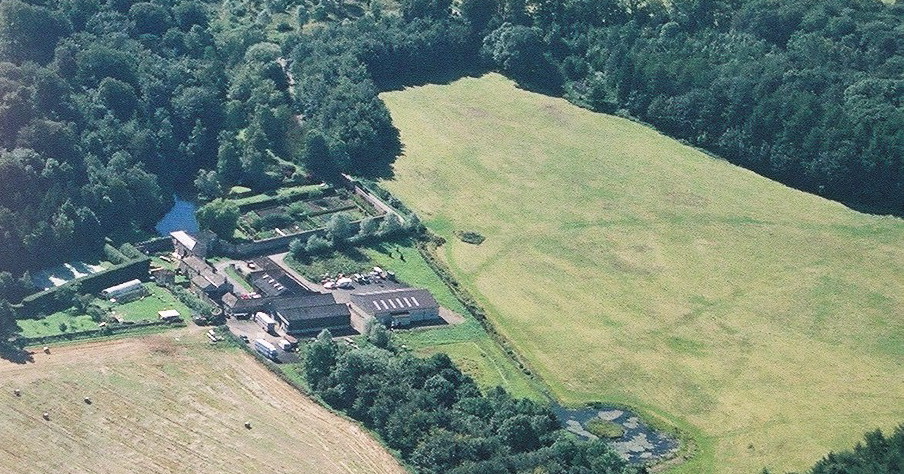 The field had been set aside for 5 years and the grass cut twice a year. The big green field to the right of the arial photo is our field and the area we earmarked for the forest garden is the top left had corner of this field. The first planting was a shelter belt along the bare field edge. A temporary rabbit fence was erected around phase 1.
The field had been set aside for 5 years and the grass cut twice a year. The big green field to the right of the arial photo is our field and the area we earmarked for the forest garden is the top left had corner of this field. The first planting was a shelter belt along the bare field edge. A temporary rabbit fence was erected around phase 1.
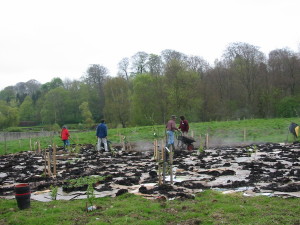
Planting started in the Forest Garden in winter 2004/5, with fruit trees and fruit bushes being planted. Over the next few months, herbs and ground cover plants such as strawberries were planted. The ground was mulched with cardboard and covered with manure, fermenting cattle fodder (sweetcorn) and straw. We harvested some soft fruit and leaves.
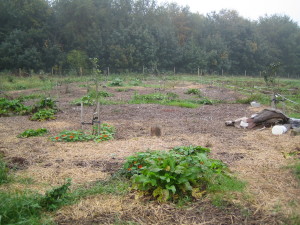
Phase 2 was planted in winter 2005/6, with more fruit trees and bushes being planted and mulched with cardboard, carpet, wood chippings and straw. Many volunteers helped with the planting and mulching. Planting continued in phase 1 and the area was filled with plants, giving a good harvest of berries, herbs and salad crops.
 Phase 3 was planted in December 2006 as part of The Tree Council's National Tree Week. The Farm received a grant from the Tree Council which enabled another 30 trees to be planted and 33 volunteers helped the planting this time. The ground was mulched with cardboard, manure and straw. A small amount of planting was done in phase 2 during 2007. Phase 1 gave a hefty harvest, particularly of strawberries (1/4 of a ton) and some of the apple and pear trees fruited.
Phase 3 was planted in December 2006 as part of The Tree Council's National Tree Week. The Farm received a grant from the Tree Council which enabled another 30 trees to be planted and 33 volunteers helped the planting this time. The ground was mulched with cardboard, manure and straw. A small amount of planting was done in phase 2 during 2007. Phase 1 gave a hefty harvest, particularly of strawberries (1/4 of a ton) and some of the apple and pear trees fruited.

Phase 4 was planted in winter 2007/8, so about 2/3rds of the 1.5 acre area has fruit trees planted. Planting the understory and ground cover continued in phases 2 and 3 with the strawberries running, raspberries spreading and herbs self seeding. Cuttings were taken from the now established bushes from phase 1 and 2 and stuck through holes cut in to the carpet in phase 3. At the end of summer, the majority had rooted and were putting on new growth. The paths are becoming a 'nursery' for self seeded plants and runners, which are removed and replanted in other areas. Yields were now at a point of being enough to share with others.
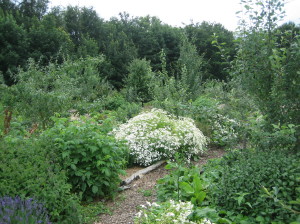 At this point, we decided two things - that we had mature enough fruit trees in order to graft onto rootstocks to plant up phase 5 and we didn't need the full 2 acres as Forest Garden as there was so much produce coming from what was planted already we didn't need any more!. So, no new tree planting was done over winter 2008/9 and we decided to have a wildlife area in the middle of the Forest Garden. Planting the other 'layers' of the Forest Garden continued in the other phases to fill gaps and get the ground covered. We also continued mulching new areas with carpet, manure and straw in preparation for the next planting. Yields of soft and hard fruit were now substantial and we gave away quite a lot.
At this point, we decided two things - that we had mature enough fruit trees in order to graft onto rootstocks to plant up phase 5 and we didn't need the full 2 acres as Forest Garden as there was so much produce coming from what was planted already we didn't need any more!. So, no new tree planting was done over winter 2008/9 and we decided to have a wildlife area in the middle of the Forest Garden. Planting the other 'layers' of the Forest Garden continued in the other phases to fill gaps and get the ground covered. We also continued mulching new areas with carpet, manure and straw in preparation for the next planting. Yields of soft and hard fruit were now substantial and we gave away quite a lot.
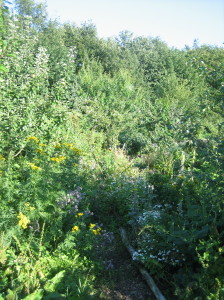 Winter of 2009/10 brought heavy snow, which banked against the rabbit fencing and the rabbits got over the fence and ring barked the grafted trees. We therefore had to wait another year to see if any had survived, so again no tree planting. Another small area was mulched and the area mulched the previous year was planted with fruit bushes, leafy greens, herbs and ground cover. Phase 1 and 2, which were mulched with cardboard not carpet, have been over-run with couch grass and there are many dock and nettle patches, meaning yeilds from the ground cover are vastly reduced. However, top fruit and berries from bushes continues to increase. Yields were now sufficient for Rachel to start Old Sleningford Preserves, and still have enough to share with others.
Winter of 2009/10 brought heavy snow, which banked against the rabbit fencing and the rabbits got over the fence and ring barked the grafted trees. We therefore had to wait another year to see if any had survived, so again no tree planting. Another small area was mulched and the area mulched the previous year was planted with fruit bushes, leafy greens, herbs and ground cover. Phase 1 and 2, which were mulched with cardboard not carpet, have been over-run with couch grass and there are many dock and nettle patches, meaning yeilds from the ground cover are vastly reduced. However, top fruit and berries from bushes continues to increase. Yields were now sufficient for Rachel to start Old Sleningford Preserves, and still have enough to share with others.
 Only 4 out of the 50 grafts we did survived, but about 35 of the rootstocks did and could be grafted on to again. However, due to other commitments, we didn't manage to get any grafting done in winter 2010/2011. Instead, we concentrated on mulching another area and keeping on top of the maintenance in the other phases, something we had neglected over the past year (mistake!). This has meant re-mulching some areas and other areas where weeds encroached smothering some of the plants. Lots of herb plants raised from seed, but the weather was too dry to plant until winter. Yields now mean we have 3 workdays in the year dedicated to picking the fruit (strawberries and rasps July, blackcurrants August and Apples October).
Only 4 out of the 50 grafts we did survived, but about 35 of the rootstocks did and could be grafted on to again. However, due to other commitments, we didn't manage to get any grafting done in winter 2010/2011. Instead, we concentrated on mulching another area and keeping on top of the maintenance in the other phases, something we had neglected over the past year (mistake!). This has meant re-mulching some areas and other areas where weeds encroached smothering some of the plants. Lots of herb plants raised from seed, but the weather was too dry to plant until winter. Yields now mean we have 3 workdays in the year dedicated to picking the fruit (strawberries and rasps July, blackcurrants August and Apples October).
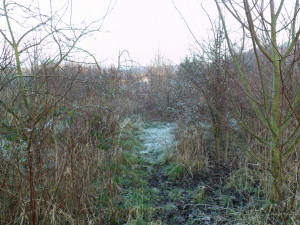 Winter 2011/2012 saw the last area of the forest garden being mulched and the grafting being done. The rootstocks were large enough to be planted directly into the Forest Garden rather than a nursey bed. The rootstocks for plums and gages need to be bud grafted in the summer, so these will go into the patch we have just mulched, and that will complete the 'structure' planting i.e. the trees. Herb plants and propogated fruit bushes planted in the area mulched last year and spaces in previous areas filled.
Winter 2011/2012 saw the last area of the forest garden being mulched and the grafting being done. The rootstocks were large enough to be planted directly into the Forest Garden rather than a nursey bed. The rootstocks for plums and gages need to be bud grafted in the summer, so these will go into the patch we have just mulched, and that will complete the 'structure' planting i.e. the trees. Herb plants and propogated fruit bushes planted in the area mulched last year and spaces in previous areas filled.
Photographs of the Forest Garden Year by Year
In the beginning.... 2006 2007 2008 2009 2010 2011


















